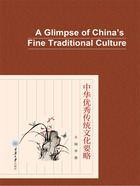
/ Dao /
The keynote of Lao Zis philosophical system is Dao, or the Way, which is the origin, the principle, the substance, and the standard of all things, to which all of them must conform. Dao gives birth to the universe and makes all things in the universe what they are. In other words, it is the law that governs the development and change of all things in the universe. It is invisible, intangible, and indescribable. It is even nameless, and Dao is just an inadequate name forced upon it.
Dao is one and simple, like the uncarved block. In its essence, it is eternal, absolute, and beyond space and time; in its operation, it is spontaneous, everywhere, constant and unceasing, always in transformation, going through cycles and finally returning to its root. It is modeled after Nature and is called the “self-so (自然).” It is good like water, always benefiting things without claiming credit. It takes no unnatural action, and yet all things flourish. Furthermore, it is nonbeing itself, not in the sense of nothingness but as not being any particular thing. When it is possessed by an individual thing, it becomes its Virtue (德), which is the principle underlying the individual thing. Dao creates all things under heaven while de (德) nurtures them. Lao Zi was progressive for his time in that he replaced a god, a Heaven, or a supreme authority that was believed to govern the universe with the Way, an absolute, overriding spirit that transcends time and space, but his theory represents the standpoint of objective idealism.
Lao Zi put forward a series of profound views on the laws governing the workings and changes of all things in the universe. According to Lao Zi, things and concepts are relative. In Chapter of the Dao De Jing (《道德经》), Lao Zi claimed, “When the world recognizes the beautiful as beautiful, there is the ugly; when the world recognizes the good as good, there is the bad (or the evil). Being and nonbeing produce each other; the difficult and the easy complement each other; the long and the short shape each other; the high and the low contain each other; the sound and the voice accord with each other; and what is before and what is after follow each other.” Generally speaking, of every pair of opposite concepts, one produces the other, or the existence of one depends on the existence of the other.
From the above mentioned relativity of things and concepts, Lao Zi continued to draw an important conclusion: “Reversion is the movement of Dao,” or turning back is how the Way moves. This saying, which means that a state or quality has its process of development, and when it reaches the extreme, it will eventually turn back to its opposite state or quality, contains some naive ideas about dialectics. To him, anything that develops extreme qualities will invariably revert to the opposite qualities. Thus the named and nameless, being and nonbeing, strength and weakness, honor and shame, wisdom and stupidity, etc., are all interdependent and grow out of one another. He said, “Its upon calamity that happiness leans; it is upon happiness that calamity rests.” Because of this truth, Lao Zi taught that, to weaken something, one should first strengthen it; to diminish something, one should first increase it. In this way, even the weakest in the world can overcome the strongest. That is to say, weakness is the function of Dao. Lao Zi unveiled the unity of opposites in the world and realized the contradictions in things and the transformation of the opposites. In his opinion, however, change did not develop in a forward fashion; instead, it went on in an endless cycle. In addition, the transformation of the opposites was absolute and unconditional.